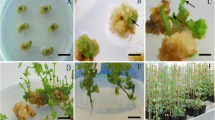Abstract
Up to 70% regenerating hypocotyls provided with 5 to 20 buds were obtained on MS medium containing 0.01 or 1 mg l-1 NAA and 0.2 mg l-1 BA or 0.2 mg l-1 BA and 0.2 mg l-1 TDZ. The ability to regenerate buds was correlated with the presence of oil glands at a stage in germination when oil secretion was not yet occurring. The regeneration of shoot meristems took place from the cells involved in the differentiation of these glands. Such glands could also appear during callus redifferentiation, giving rise to indirect regeneration. Rooting of the regenerants was efficient using a two-step procedure of induction under darkness in the presence of 3 mg l-1 IBA, followed by root development on medium devoid of growth regulators under a 16-h photoperiod, the medium being solidified with Gelrite. Regenerated plants showed no phenotypic alterations. Nuclear DNA contents in mother-plant material and regenerants were analysed using flow cytometry. There was no evidence of polyploidy in any of the samples, indicating the absence of polyploidisation during cell differentiation and under in vitro conditions. No regeneration was obtained from leaf or stem explants from micropropagated plantlets.
Similar content being viewed by others
References
Adam S, Chriqui D & Caissard JC (1992) Transformation g´en´etique et r´eg´en´eration de bourgeons transg´eniques chezEucalyptus globulus. AFOCEL 1991, 'Biotechnologies appliqu´ees aux arbres forestiers', Paris (pp 81–110) ISSN 0398-494X
Bennett IJ & McComb JA (1982) Propagation of Jarrah (Eucalyptus marginata) by organ and tissue culture. Aust. For. Res. 12: 121–127
Bergounioux C, Perennes C, Brown S, Sarda C & Gadal P (1988) Relation between protoplast division, cell-cycle stage and nuclear chromatin structure. Protoplasma 142: 127–136
Bornman CH (1983) Possibilities and constraints in the regeneration of trees from cotyledonary needles of Picea abies in vitro. Physiol. Plant. 57: 5–16
Carr DJ & Carr SGM (1970) Oil glands and ducts in Eucalyptus l'H´erit. II. Development and structure of oil glands in the embryo. Aust. J. Bot. 18: 191–212
Cheah KT & Cheng TY (1978) Histological analysis of adventitious bud formation in cultured Douglas fir cotyledon. Am. J. Bot. 65:845–849
David A, David H & Mateille T (1982) In vitro adventitious budding on Pinus pinaster cotyledons and needles. Physiol. Plant. 56:102–107
Diallo N & Duhoux E (1984) Organogenèse etmultiplication in vitro chez l'Eucalyptus camaldulensis. J. Plant Physiol. 115: 177–182
Grattapaglia D & Bradshaw HD Jr (1994) Nuclear DNA content of commercially important Eucalyptus species and hybrids. Can. J. For. Res. 24: 1074–1078
Gupta PK & Mascarenhas AF (1983) Essential oil production in relation to organogenesis in tissue cultures of Eucalyptus citriodora Hook. In: Sen SK & Giles KL (eds) Plant Cell Culture in Crop Improvement (pp 299–308). Plenum Press, New York
Gupta PK & Mascarenhas AF (1987) Eucalyptus. In: Bonga JM & Durzan DJ (ed) Cell andTissueCulture in Forestry, Vol 3 (pp 385–399). Martinus Nijhoff Publisher, Dordrecht, The Netherlands
Hare PD & Van Staden J (1994) Inhibitory effect of thidiazuron on the activity of cytokinin oxidase isolated from soybean callus. Plant Cell Physiol. 35: 1121–1125.
Hartney VJ (1980) Vegetative propagation of the Eucalyptus. Aust. For. Res. 10: 191–211
Huetteman CA & Preece JE (1993) Thidiazuron -Apotent cytokinin forwoody plant tissue culture. Plant Cell Tiss. Org. Cult. 33: 105–119
Kitahara EH & Caldas LS (1975) Shoot and root formation in hypocotyl callus cultures of Eucalyptus. For. Sci. 21: 242–243
Kondrasheva NYU & Yatsenko-Khmelevsky AA (1974) Aptitude de l'´epith´elium des conduits r´esinifères du pin à la formation des cals en culture de tissus. Bjull. Moskov. Obshchest. Ispytalelej Prirody, otd bid., SSSR, 79: 132–139
Lain´e E & David A (1994) Regeneration of plants from leaf explants of micropropagated clonal Eucalyptus grandis. Plant Cell Rep. 13: 473–476
Lison L (1960) Histochimie et cytochimie animales. Gauthiers-Villars (ed) Paris
Lloyd G & McCown B (1981) Commercially-feasible micropropagation of mountain laurel, Kalmia latifolia, by use of shoot-tip culture. Intern. Plant Propagators' Soc. Combined Proc. 30: 421–427
Marie D & Brown SC (1993) A cytometric exercise in plant DNA histograms, with 2C values for 70 species. Biol. Cell 78: 47–51
McComb JA (1994) Clonal propagation of eucalypts. In: Lindsey K (ed) Plant Tissue Culture Kluwer, Dordrecht, The Netherlands
McComb JA & Bennett IJ (1986) Eucalypts (Eucalyptus spp.). In: Bajaj YPS (ed) Biotechnology in Agriculture and Forestry, Vol 1 (pp 340-362). Springer Verlag, Berlin, Heidelberg
Mehra-Palta A (1982) Clonal propagation of Eucalyptus by tissue culture. Plant Sci. Lett. 26: 1–11
Monnier M, Tranvan H & Thomas M(1983) Evolution du cotyl´edon isol´e en culture in vitro. Bull. Soc. Bot. Fr. (Actualit´es botaniques)130: 57–66
Muralidharan EM & Mascarenhas AF (1987) In vitro plantlet formation by organogenesis in Eucalyptus camaldulensis and by somatic embryogenesis in Eucalyptus citriodora. Plant Cell Rep. 6: 256–259
Murashige T & Skoog F (1962) A revised medium for rapid growth and bio-assays with tobacco tissue cultures. Physiol. Plant. 15:473–497
Oka S, Yeng EC & Thorpe TA(1982) Shoot formation in Eucalyptus globulus hypocotyl explants. N. Z. J. For. Sci. 12: 501–509
Peterson RL, Scott MG & Ellis BE (1978) Structure of stem-derived callus of Ruta graveolens: Meristems, leaves and secretory structures. Can. J. Bot. 56: 2717–2729
Subbaiah MM & Minocha SC (1990) Shoot regeneration from stem and leaf callus of Eucalyptus tereticornis. Plant Cell Rep. 9: 370–373
Teulières C & Boudet AM (1992) Obtention et explication de systèmes simplifi´es (cellules, protoplastes) chez le genre Eucalyptus en vue de l'´etude et de l'am´elioration de la r´esistances au froid. AFOCEL 1991, 'Biotechnologies appliqu´ees aux arbres forestiers', Paris, 127–156, ISSN 03998-494X
White PR (1943) A Handbook on Plant Tissue Culture. J. Cattell Press, Lancaster Penn
Yeung EC, Aitken J, Biondi S& Thorpe T (1981) Shoot histogenesis in cotyledon explants of Radiata pine. Bot. Gaz. 142: 494–501
Author information
Authors and Affiliations
Rights and permissions
About this article
Cite this article
Azmi, A., Noin, M., Landré, P. et al. High frequency plant regeneration from Eucalyptus globulus Labill. hypocotyls: Ontogenesis and ploidy level of the regenerants. Plant Cell, Tissue and Organ Culture 51, 9–16 (1997). https://doi.org/10.1023/A:1005920807555
Issue Date:
DOI: https://doi.org/10.1023/A:1005920807555




